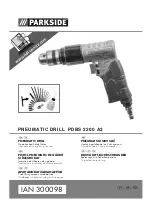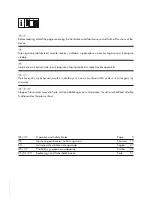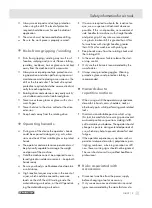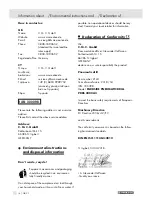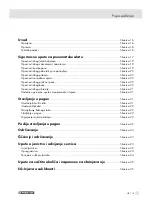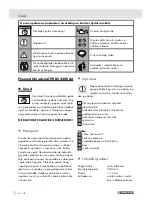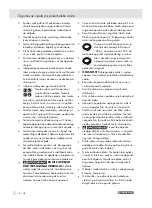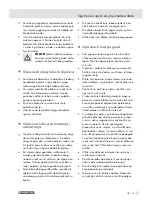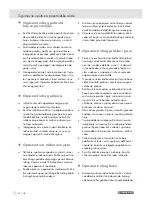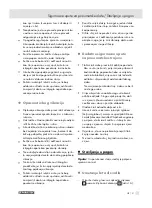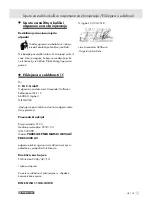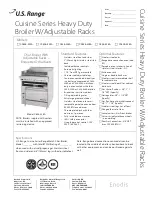
10 GB/CY
Safety information for air tools
not use other accessory and material types
and sizes.
Avoid direct contact with the machine tool dur-
ing and after use, as it may become very hot
or sharp-edged.
Hazards in the work
environment
Slipping, tripping and falls are main causes of
injuries at the workplace. Be mindful of surfaces
which may have become slippery during ma-
chine use, and of tripping hazards caused by
the air- or hydraulic hose.
Proceed with caution in unfamiliar surroundings.
These may hold hidden dangers due to electri-
cal cables or supply lines.
The drill is not suitable for use in explosive envi-
ronments and is not insulated against contact
with electrical power sources.
Verify there are no electrical lines, gas lines,
etc. which may result in a hazard in the event
they are damaged during machine use.
Hazards due to dust
and vapours
Dusts and vapours generated by use of drill
connections may result in damage to the health
(e.g. cancer, birth defects, asthma and / or der-
matitis); it is imperative to perform a risk assess-
ment for these hazards and implement the
respective regulatory mechanisms.
The risk assessment should include dust genera-
ted from machine use and dust in the area pos-
sibly being blown around.
Use and maintain the drill or thread cutter as
recommended in these instructions to minimise
the release of dust and vapours.
Exhaust air must be discharged so the amount
of dust being blown about in a dusty environ-
ment is minimised.
If dust or vapours are generated the principal
task must be to monitor them in the area where
they are released.
All machine mounting parts or accessories in-
tended to collect, extract or eliminate airborne
dust or vapours should be used and maintained
according to manufacturer instructions.
Select, maintain and replace consumables and
machine tools as recommended in these in-
structions to prevent an unnecessary increase
in the production of dust or vapours.
Use respiratory dust equipment as required by
labour- and health regulations.
Noise hazards
With inadequate ear protectors the impact of
high noise levels may result in permanent hea-
ring damage, hearing loss and other problems,
e.g. tinnitus (ringing, whistling or buzzing in the
ear).
It‘s imperative to perform a risk assessment for
these hazards and implement the suitable regu-
latory mechanisms.
Suitable regulatory mechanisms to minimise the
risk include measures such as using insulation
to prevent pinging sounds on work pieces.
Use heating protection as required by labour-
and health regulations.
The drill must be operated and maintained as
recommended in these instructions to prevent
an unnecessary increase in the noise level.
If the drill features a silencer, always ensure it is
available when using the drill and in good wor-
king order.
Select, maintain and replace consumables and
machine tools as recommended in these instruc-
tions to prevent an unnecessary increase in the
sound level.
Hazard due to vibration
Exposure to vibration may cause damage to
the nerves and disturb blood circulation in hands
and arms.
Wear warm clothes when working in cold envi-
ronments and keep hands warm and dry.
Summary of Contents for PDBS 2200 A3
Page 3: ......
Page 4: ......
Page 26: ...26...
Page 38: ...38...
Page 40: ...40 GR CY PDBS 2200 A3 1 2 3 4 5 6 7 8 9...
Page 42: ...42 GR CY...
Page 43: ...43 GR CY 6 8 bar 125 psi 150 6 8 bar...
Page 44: ...44 GR CY 4Nm 10Nm...
Page 45: ...45 GR CY...
Page 46: ...46 GR CY...
Page 47: ...47 GR CY 1 9 A 10 1 11 A 10 1 9 B 10 11 A C 9mm 8 8 D 8 6 8bar...
Page 48: ...48 GR CY 10m 9mm 0 6 bar 3 3 4 4 F 4 R 5 3 8 SAE10 20 a 8...
Page 49: ...49 GR CY b 3 5 5 10 5 Creative Marketing Consulting GmbH 3 O 2251 1994...
Page 52: ...52...

